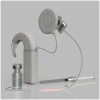Is there an unmet medical need for improved hearing restoration?
- PMID: 35833443
- PMCID: PMC9358394
- DOI: 10.15252/emmm.202215798
Is there an unmet medical need for improved hearing restoration?
Abstract
Hearing impairment, the most prevalent sensory deficit, affects more than 466 million people worldwide (WHO). We presently lack causative treatment for the most common form, sensorineural hearing impairment; hearing aids and cochlear implants (CI) remain the only means of hearing restoration. We engaged with CI users to learn about their expectations and their willingness to collaborate with health care professionals on establishing novel therapies. We summarize upcoming CI innovations, gene therapies, and regenerative approaches and evaluate the chances for clinical translation of these novel strategies. We conclude that there remains an unmet medical need for improving hearing restoration and that we are likely to witness the clinical translation of gene therapy and major CI innovations within this decade.
Keywords: clinical translation; cochlear implant; gene therapy; hearing impairment; optogenetic hearing restoration.
© 2022 The Authors. Published under the terms of the CC BY 4.0 license.
Figures





Similar articles
-
Towards the optical cochlear implant: optogenetic approaches for hearing restoration.EMBO Mol Med. 2020 Apr 7;12(4):e11618. doi: 10.15252/emmm.201911618. Epub 2020 Mar 30. EMBO Mol Med. 2020. PMID: 32227585 Free PMC article. Review.
-
Towards optogenetic approaches for hearing restoration.Biochem Biophys Res Commun. 2020 Jun 25;527(2):337-342. doi: 10.1016/j.bbrc.2019.12.126. Epub 2020 Feb 4. Biochem Biophys Res Commun. 2020. PMID: 32033755 Review.
-
Toward Personalized Diagnosis and Therapy for Hearing Loss: Insights From Cochlear Implants.Otol Neurotol. 2022 Sep 1;43(8):e903-e909. doi: 10.1097/MAO.0000000000003624. Otol Neurotol. 2022. PMID: 35970169
-
Understanding and treating paediatric hearing impairment.EBioMedicine. 2021 Jan;63:103171. doi: 10.1016/j.ebiom.2020.103171. Epub 2021 Jan 7. EBioMedicine. 2021. PMID: 33422987 Free PMC article. Review.
-
Hearing loss.Otolaryngol Clin North Am. 2009 Feb;42(1):79-85, ix. doi: 10.1016/j.otc.2008.09.008. Otolaryngol Clin North Am. 2009. PMID: 19134492
Cited by
-
Glycyrrhizic acid and its carrier-free micellar formulation: Unraveling the potential for enhanced oral prevention of hearing loss.Int J Pharm X. 2025 May 26;9:100340. doi: 10.1016/j.ijpx.2025.100340. eCollection 2025 Jun. Int J Pharm X. 2025. PMID: 40521160 Free PMC article.
-
Catching up but still miles behind-a patient registry for otoferlin.Exp Mol Med. 2024 Jun;56(6):1472-1473. doi: 10.1038/s12276-024-01247-6. Epub 2024 Jun 3. Exp Mol Med. 2024. PMID: 38825639 Free PMC article. No abstract available.
-
G protein-coupled receptors in cochlea: Potential therapeutic targets for hearing loss.Front Mol Neurosci. 2022 Oct 12;15:1028125. doi: 10.3389/fnmol.2022.1028125. eCollection 2022. Front Mol Neurosci. 2022. PMID: 36311029 Free PMC article. Review.
-
MSC-derived exosomes protect auditory hair cells from neomycin-induced damage via autophagy regulation.Biol Res. 2024 Jan 13;57(1):3. doi: 10.1186/s40659-023-00475-w. Biol Res. 2024. PMID: 38217055 Free PMC article.
-
Graded optogenetic activation of the auditory pathway for hearing restoration.Brain Stimul. 2023 Mar-Apr;16(2):466-483. doi: 10.1016/j.brs.2023.01.1671. Epub 2023 Jan 23. Brain Stimul. 2023. PMID: 36702442 Free PMC article.
References
-
- Al‐Moyed H (2019) Dual‐AAV mediated transfer of full‐length otoferlin cDNA into auditory inner hair cells and the effects of different mutations in the OTOF gene on the protein levels and cellular distribution of otoferlin in auditory inner hair cells. Göttingen: Georg‐August‐Universität Göttingen;
-
- Ashmore J (2008) Cochlear outer hair cell motility. Physiol Rev 88: 173–210 - PubMed
Publication types
MeSH terms
LinkOut - more resources
Full Text Sources
Medical

